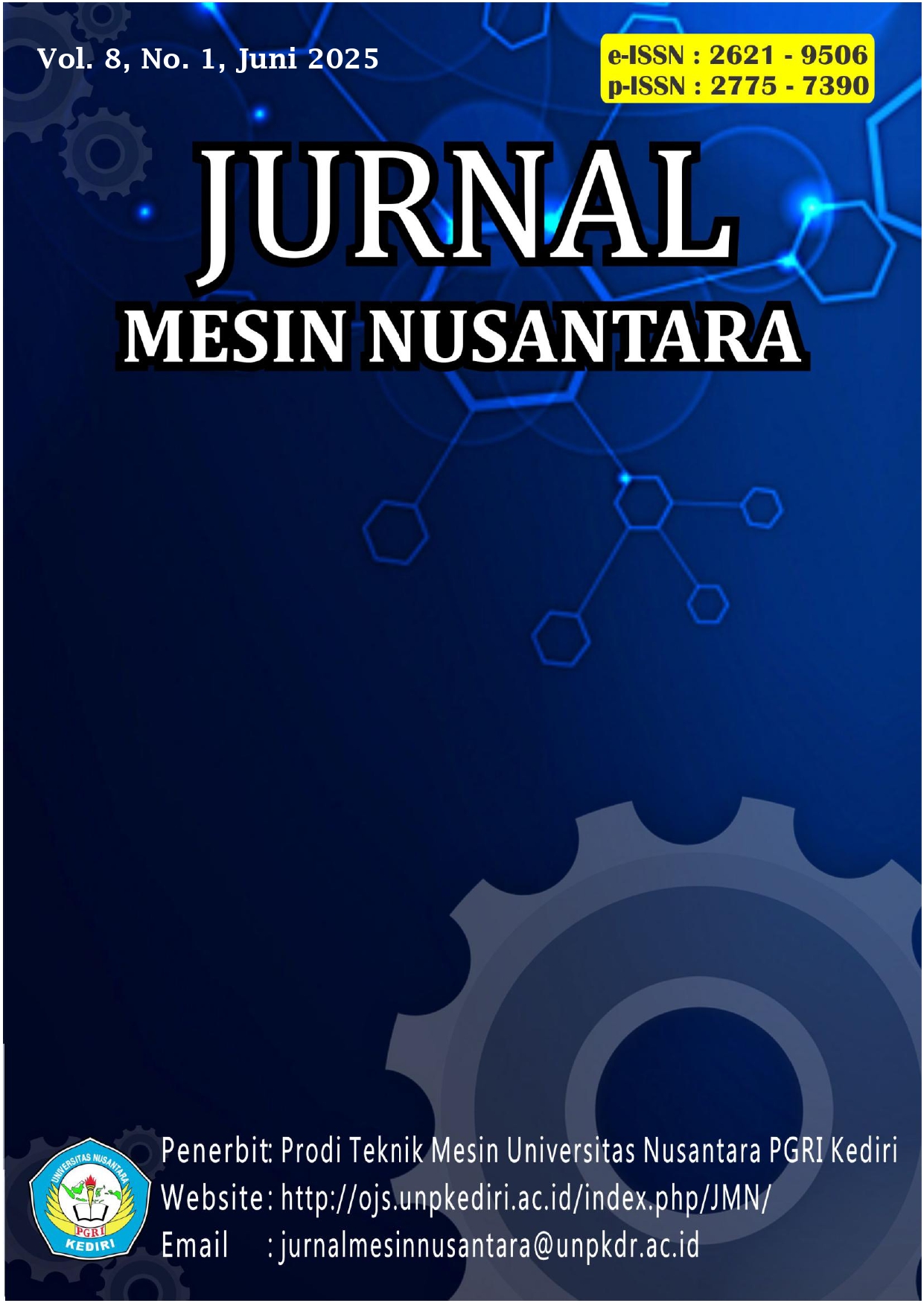Pembuatan Bioetanol Dengan Cara Fermentasi Dari Singkong dan Beras Ketan Putih Campur Ragi
DOI:
https://doi.org/10.29407/jmn.v8i1.23498Keywords:
bioethanol, cassava, distillation, fermentation, yeastAbstract
Produksi bioetanol dapat dilakukan dari bahan baku yang mengandung glukosa, seperti ubi kayu (singkong) dan beras ketan putih. Salah satu bahan baku yang ekonomis adalah molases. Molases merupakan hasil sampingan dari produksi gula dan mengandung kadar gula sekitar 50%-60%, serta asam amino dan mineral. Molases memiliki keunggulan karena dapat langsung dikonversi menjadi etanol tanpa memerlukan proses pretreatment dan liquifikasi. Penelitian ini bertujuan untuk memproduksi bioetanol dari singkong dan beras ketan putih melalui fermentasi menggunakan ragi tape. Variasi dalam penelitian ini meliputi rasio ragi (10 gram, 15 gram, 20 gram), penambahan glukosa (11 gram), dan lama fermentasi (6 hari, 8 hari, 10 hari). Hasil penelitian menunjukkan bahwa pada singkong, volume fermentasi terendah adalah 410 ml dan volume destilasi tertinggi adalah 70 ml dengan waktu fermentasi 6 hari dan penggunaan 10 gram ragi. Volume fermentasi tertinggi untuk singkong tercapai sebesar 520 ml, dengan volume destilasi tertinggi 270 ml pada waktu fermentasi 10 hari dan penggunaan 20 gram ragi. Untuk beras ketan putih, volume fermentasi terendah tercatat sebesar 175 ml, dengan volume destilasi tertinggi 25 ml pada waktu fermentasi 6 hari dan penggunaan 10 gram ragi. Volume fermentasi tertinggi untuk beras ketan putih mencapai 270 ml, dengan volume destilasi tertinggi 110 ml pada waktu fermentasi 10 hari dan penggunaan 20 gram ragi.
Downloads
References
[1] Direktorat Jenderal Tanaman Pangan. Laporan Tahun 2023.
[2] E. Lovisia, "Bioetanol dari singkong sebagai sumber energi alternatif," Science Physics Education Journal, vol. 6, no. 1, pp. 8-14, 2022.
[3] H. Rikana and R. Adam, "Pembuatan bioethanol dari singkong secara fermentasi menggunakan ragi tape," presented at the Seminar Tugas Akhir S1 Teknik Kimia UNDIP 2009, R. A22 Lt.2 Gedung A Teknik Kimia UNDIP, 2009.
[4] K. C. Sembiring, H. Mulyani, I. F. A, D. Dahnum, and Y. Sudiyani, "Rice Flour and White Glutinous Rice Flour for Use on Immobilization of Yeast Cell in Ethanol Production," Energy Procedia, vol. 32, pp. 99-104, 2013/01/01/ 2013.
[5] A. Y. M. Simanjuntak and R. Subagyo, "Analisis Hasil Fermentasi Pembuatan Bioetanol Dengan Variasi Waktu Menggunakan Bahan (Singkong, Beras Ketan Hitam dan Beras Ketan Putih)," Scientific Journal of Mechanical Engineering Kinematika, vol. 4, no. 2, pp. 79-90, 2019.
[6] R. Subagyo, A. E. Pristiwanto, and Muchsin, "Studi eksperimental pembuatan bioetanol hasil fermentasi beras ketan putih, ketan hitam dan singkong," Dinamika : Jurnal Ilmiah Teknik Mesin, vol. 11, no. 2, pp. 84-93, 2020.
[7] D. K. Roy and M. Z. Abedin, "Potentiality of biodiesel and bioethanol production from feedstock in Bangladesh: A review," Heliyon, vol. 8, no. 11, 2022.
[8] T. Goda et al., "Natural variation in the glucose content of dilute sulfuric acid–pretreated rice straw liquid hydrolysates: implications for bioethanol production," Bioscience, Biotechnology, and Biochemistry, vol. 80, no. 5, pp. 863-869, 2016.
[9] M. Gustina, J. Jalaluddin, N. ZA, S. Bahri, and . M., “PENGARUH LAMA WAKTU FERMENTASI TERHADAP KADAR BIOETANOL DARI PATI UBI JALAR UNGU (Ipomea batata L),” Chem. Eng. J. Storage, vol. 2, no. 2, p. 116, 2022, doi: 10.29103/cejs.v2i2.6604.
[10] M. Falaah and H. Kusumayanti, “Proses Fermentasi pada Produksi Bioetanol Dedak Padi dengan Hidrolisis Enzimatis,” Metana, vol. 17, no. 2, pp. 81–87, 2021, doi: 10.14710/metana.v17i2.43335.
Downloads
Published
Issue
Section
License
Copyright (c) 2025 Amrullah, Akhiruddin, Muhammad Syahrir, Sulaiman, Rustam Efendi

This work is licensed under a Creative Commons Attribution-ShareAlike 4.0 International License.
Authors who publish with this journal agree to the following terms:
- Copyright on any article is retained by the author(s).
- The author grants the journal, right of first publication with the work simultaneously licensed under a Creative Commons Attribution License that allows others to share the work with an acknowledgment of the work’s authorship and initial publication in this journal.
- Authors are able to enter into separate, additional contractual arrangements for the non-exclusive distribution of the journal’s published version of the work (e.g., post it to an institutional repository or publish it in a book), with an acknowledgment of its initial publication in this journal.
- Authors are permitted and encouraged to post their work online (e.g., in institutional repositories or on their website) prior to and during the submission process, as it can lead to productive exchanges, as well as earlier and greater citation of published work.
- The article and any associated published material is distributed under the Creative Commons Attribution-ShareAlike 4.0 International License












